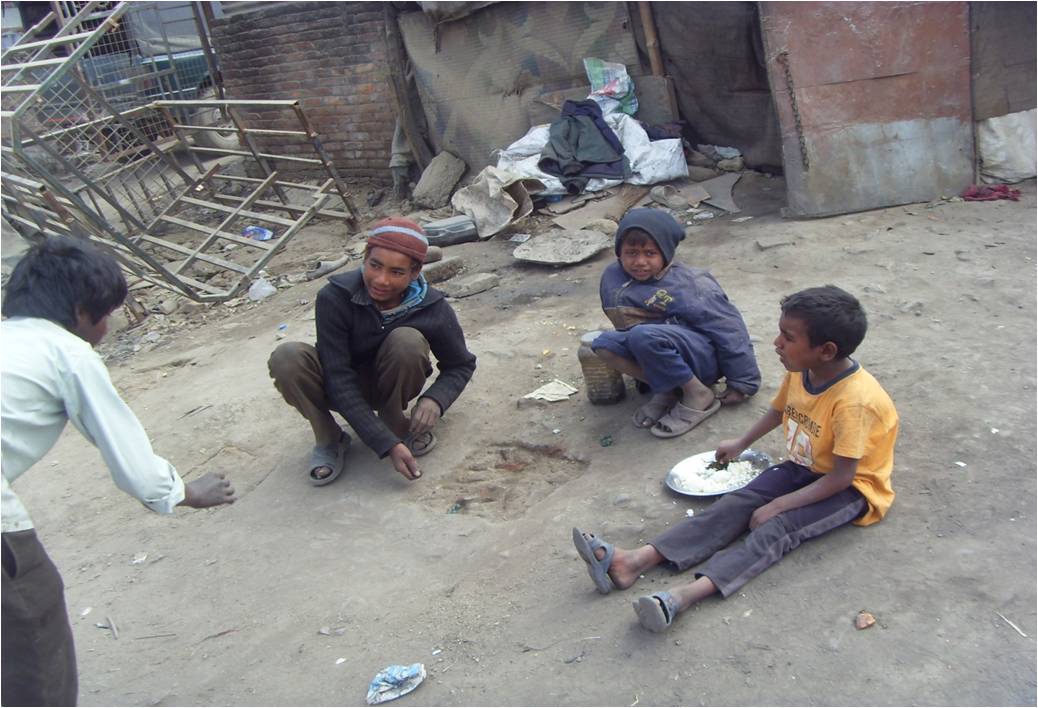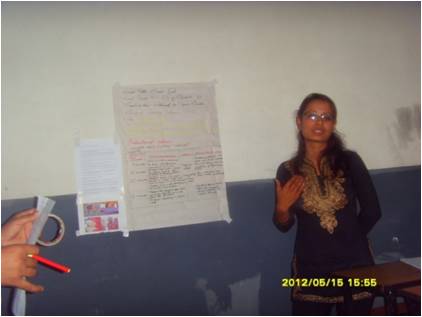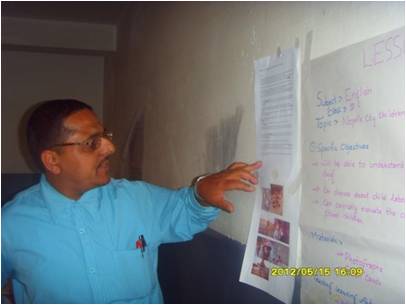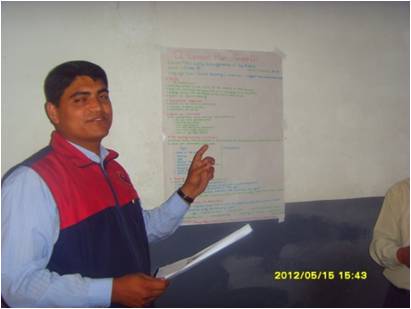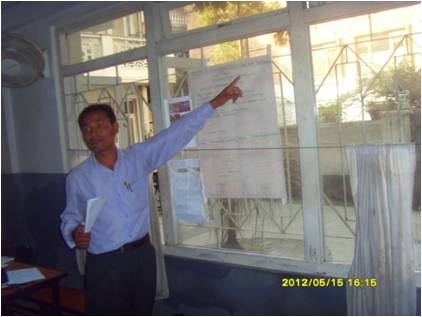–Uttam Gaulee
“How can I sit on the girls’ bench?”his eyes staring at me, as if I had forced him to do something very objectionable. All the students in the classroom burst into laughter. This was a sixth grade boy at an English medium school I was teaching in West Nepal a dozen years ago. I showed the only available seat for him to sit.This boy had arrived late in the class, and afterperforming a customary “May I come in sir?” at the door, had entered the class. I expected him to take the only available seat but he wouldn’t sit down. I felt obliged to show him the only available space for him to sit and I encouraged him to sit there. The bench was shared by four other students–all girls! He would rather stand up for the entire period rather than condescend to sit on the bench with theother sex.Why would he? Wouldn’t he be insulted by all other friends afterwards? Anyway, I smiled to myself, feeling proud as his English teacher, because he spoke out his feeling so nicely in English.
We are all familiar with the typical Nepali high school classroom: girls flocked together at one side of the class in a couple of benches, and boys taking up all the rest of the available seats. Girls are often a minority and they feel secure when together with other girls. How do you arrange boys and girls in your classroom? Boys and girls alternatively, or all the girls together at one side and all the boys at the other? Or do you teach only boys and/or girls in the “boys-only” or “girls-only” schools? We do have some Kanya schools in Kathmandu such as Ishwari Kanya and Balkumari Kanya Vidhayalaya. Why did St. Xavier’s switch to co-ed at the turn of the century after serving as the “boys-only” school for half a century?Are there schools still in place where only boys are taught, perhaps in some Sanskrit or army schools? What is the rationale behind single sex education? How do these schools compete with their co-ed counterparts?Do boys learn differently than girls? Do boys and girls distract each other in learning process? Shall we rather separate boys and girls in schools or even have entirely different schools for boys and girls, so that they learn better? In this piece, I review an interesting article and present an interview that I conducted with one student as a way of testing the article’s arguments. I would be glad to hear what fellow Nepali teachers think about the issue of gender in education in general and teaching English in specific.
In “Single-Sex Classrooms Are Succeeding,”[1] Michael Gurian, Kathy Stevens, and Peggy Daniels say “yes” to the questions I asked above. The authors argue that their institute, the Gurian Institute, has trained thousands of teachers from a wide range of schools from fifteen countries, including more than two thousand schools and districts of the USA. Hence, they claim that having worked with all kinds of schools; they have seen “what is working and what is not working around the globe.” As strong advocates of single-sex education, the authors have been able to argue very convincingly that single-sex classrooms are succeeding and that the phenomenon has been gaining popularity again. This popularity is happening despite many legal and attitudinal barriers over the past decade, particularly after the announcement of a change of regulation by the US Department of Education in October 2006.
One of the main reasons cited for promoting single-sex instruction is that boys and girls have both brain and learning differences. Putting forward their argument of single-sex instruction, the authors state that such instruction “offers specific gender friendly opportunities” for expediting learning by the use of their resources and techniques, which many schools featured in the article have found helpful in setting up and maintaining successful single-sex programs. The article features a series of stories about single-sex education piloted by many different schools in the United States that have utilized the single-sex program model and verified its success. Also, they have experimentally verified the results in different modalitiesranging from whole single-sex academies to single-sex core programs andoptional single-sex classes.
There have been widespread successes in single-sex classrooms throughout USA. After single-sex programs were implemented, usually by teachers of the same gender as their students, but not always, achievement on state assessment tests greatly improved, causing some schools like Roosevelt Middle School in Oklahoma, to be taken off the “at risk” list. Some schools, like B.E.S.T Academy, focused on reading instruction for boys and technology instruction for girls. Moreover, a public high school in Arkansas specifically worked with struggling boys who were failing in various subjects and having problems with the transition to high school. Within two years, the high school found that very few of the boys failed. But not only this, discipline referrals also went down by one third. An independent college preparatory school in North Carolina implemented single-sex instruction and found many advantages in four years’ time, such as stronger mentoring relationships, more trust and feelings of attachment between the students and teachers, more stress reduction, anda greater production of new energy for the teaching and learning environment.
Success testimonials from principals, teachers, students, parents and even counselors all chime in to the wonderful achievement stories of the new initiative. One of the counselors writes to the authors, “There is something incredible taking place …a contagious excitement in the air that goes down to our students. It’s not just me – I am hearing it across divisions – I’m glad to be a part of it too.” While the authors cited many glowing examples of schools implementing and finding success in single-sex programs demonstrating that teachers and students found that the classroom environment and academic achievement improved, very few details were given about how boys and girls learn differently. Also missing from the article were instructional strategies teachers could use to better teach these genders.
I interviewed a person who had had some experience of both single-sex and co-ed schooling and interestingly, she is herself a part-time teacher currently teaching boys and girls in 6th grade. She went to an all-girl Catholic high school for grades 9-12, but she was in a co-ed elementary school for grades up to the 8th grade. I think she can be another testimonial for the authors. Reflecting on her experiences, she remembers in 7th and 8th grade at a co-ed Catholic elementary school she was “a lot more interested in boys.” However, “…at the high school, I could focus more on learning and was not afraid to participate in class.” She did take Honors Physics and A.P Physics, as well as Calculus for college credit, due to the suggestion of her Chemistry teacher, who was a male. She doesn’t remember favoring female teachers over male teachers, though. “Actually my History and Chemistry teachers (both male) were my favorite teachers because of their kindness, ability to make the class interesting, and their positive feedback.” Her physics teacher, also male, was not her favorite teacher but she did enjoy the challenging work and high standards for organized notes and classwork that he expected.
When I asked if she would have advanced in the math and sciences if Oakland Catholic would have had boys too, she answers, “Hard to say, I might have been more self-conscious and less focused, but truly hard to say.” She believes that in those years where she was forming her identity, she needed to not be distracted by the opposite sex and concentrate on growing academically, and even taking leadership roles at the Catholic religious retreat, “Kairos.”
As a current six grade teacher, she is very surprised to read of a gender achievement gap. She had worked for four years at a predominantly African American school where the racial achievement gap was discussed and shown in presentations.Asked for her thoughts on the reduction in the disciplinary referral for boys, she also wonders if teachers who only taught one gender were fairer if their student population shared their gender. Were female teachers fairer with girls and male teachers fairer with boys? Would co-ed classes show that male teachers disciplined girls differently and female teachers discipline boys differently? “Are we more open-minded with students who are more like us because we understand them?” She wants to learn more about it too.
While she thought more of brain and gender differences in terms of boys being more active and less willing to sit and study than girls are, as well as the stereotypes of boys being more interested in Math and Science while girls prefer Language Arts, she never really heard much thought about other ways they could be different. She is definitely interested in learning more about these differences now. “I briefly looked at an article about gender learning differences, and while I didn’t understand the Math concept, as it was higher Math, I could see how the teachers tapped more into the boys’ interests by just diving right into the material, while with the girls, their emotions were tapped into in regards to their curiosity about the mathematician, stories that surrounded the concept, real-life application, where they brought flowers and other objects in to use for the lesson.” The article for that suggested using “story problems” for girls because they want more of the real-life application than boys do.
She is intrigued by the section of the article that points out that due to single-sex education, the classroom environment improved, where teachers and students felt more connected to each other, and there was a greater sense of trust. Continuing this thought, my subject wondered when teachers “start from scratch” and not stick to the same routine and classroom set-up, if that helps them be creative and enthusiastic, and the students, sensing that, are more motivated to learn as a result.
The article sounds like a promotion of the authors’ institute in the beginning for a couple of reasons. First, the authors own the institute themselves. Second, they have made a lot of claims bolstered by lots of evidences and testimonials. As much as they seems to be set out to sell their products in describing how their professional development plan for the teachers have been highly effective, they do have compelling elements in in the article.
After the discussion with my subject, another skeptical thought came to my mind. Every new idea comes with a promise and enthusiasm, such as a newly released film, and the charm wanes gradually with time.Did the teachers become more creative and/or students more motivated simply because it was just another “new idea?” This notion of ephemeral fascination cannot be generalized to all innovations though, as there are someeducational reform movements like B.F. Skinner’s behaviorism, that have perpetual influence in the educational field, even after losing dominance for a long time.
There aretwo most compelling argumentsin the article: (1) the brains of girls and boys develop along different trajectories, and (2) thefactor of being conscious towards the opposite sex during the onset of puberty causes underachievement. However, details regarding these statements are not discussed much in the article. The interview with my subject also prompted me to reflect my own high school days. Boys and girls never sat on the same bench. Actually, all the girls flocked together in a couple of benches set to one side of the classroom while boys were on different rows. In spite of this arrangement of seating, we boys used to be very conscious about the girls’ presence in the class. It was a big distracting factor for most of us, not only in high school, but also in elementary school often times. Most of the boys were hesitant to speak out their thoughts in class because they feared the embarrassment that would entail in front of the girls if what they said was not accepted by the teacher—and the chance of rejection was always high as the teachers were too much obsessed with right or wrong and little did they care about accepting different thoughts.
While this reappearance of single-sex education has attracted the attention of educators, policymakers and parents, Dr. Leonard places a caveat on the possible global acceptance of single-sex education, though she doesn’t say anything about the success in school, per se. Her findings have ‘fuelled claims from teachers’ leaders and education psychologists that boys brought up in a single-sex environment are less able to relate to the opposite sex than those taught in a co-educational school. There is no such effect on the girls as “Girls seem to learn what the nature of the beast is if they have been to single sex schools whereas boys taught on their own seem to find girls more puzzling.” [2] This leads me to conclude that although co-education has a promise to foster natural human development, and that there are a host of other factors such as motivation contributing to the success of education, the modality of single sex classrooms does seem to have many advantages to consider and their book, I am sure, has a lot to offer for the teachers while opening an important issue for further research in different contexts.
I would like to hear what fellow Choutari readers think about this issue in the case of Nepal. Where are we in terms of single sex and co-ed discussion? Do we need to have it?
Notes:
[1] The article that the author is reviewing in this work can be viewd at: http://www.eric.ed.gov/PDFS/EJ849022.pdf
[2] Professor Diana Leonard, from the Institute of Education, University of London at a conference at the Perse School for Girls in Cambridge.
[ 3] See http://www.singlesexschools.org/research-learning.htm for single sex issue
Like this:
Like Loading...

